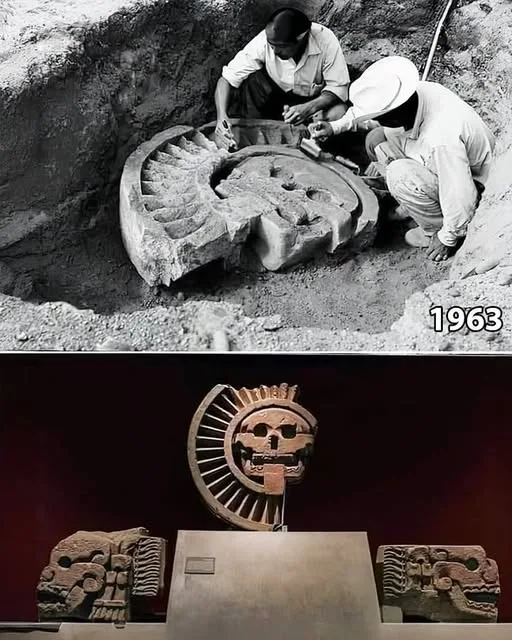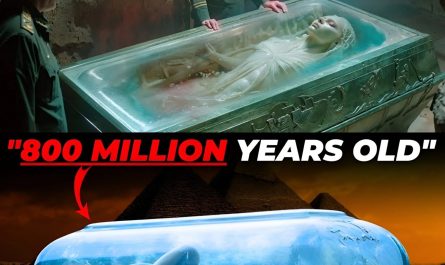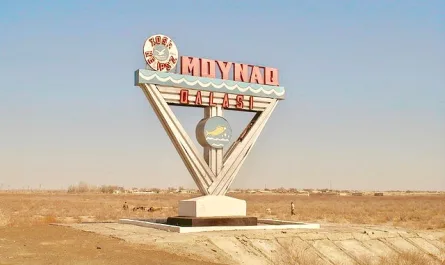In 1963, archaeologists unearthed a haunting yet mesmerizing artifact at the base of the Pyramid of the Sun in Teotihuacan, Mexico: the Disk of Mictlāntēcutli, also known as the “Disk of Death.” This ancient basaltic rock sculpture, dating back over 1,500 years, depicts Mictlāntēcutli, the Aztec god of the underworld, ruler of Mictlān. With its grinning skull, protruding tongue, and pleated paper headdress, the disk is a striking embodiment of the Aztecs’ complex beliefs about death and rebirth. Found in the shadow of one of Mesoamerica’s grandest monuments, this artifact bridges the enigmatic Teotihuacan civilization with the later Aztec culture, offering profound insights into their shared cosmology. Drawing on recent web sources, let’s explore the disk’s discovery, its cultural significance, and the mysteries it continues to evoke.

Discovery at the Pyramid of the Sun
The Disk of Mictlāntēcutli was uncovered in 1963 at Teotihuacan, a sprawling pre-Columbian city 50 kilometers northeast of modern Mexico City, famed for its monumental pyramids and urban sophistication. Teotihuacan thrived from approximately 100 BCE to 650 CE, long before the Aztec Empire (1325–1521 CE). The disk, carved from basaltic rock between 1 CE and 600 CE, was found at the foot of the Pyramid of the Sun, the largest structure in Teotihuacan, standing 213 feet tall and measuring 225 meters across. This location, a sacred epicenter, suggests the disk was a significant offering, possibly left by Aztec pilgrims who revered Teotihuacan as the “place where the gods were created.”
The disk’s discovery came during a period of intense archaeological exploration at Teotihuacan, coordinated by Mexico’s National Institute of Anthropology and History (INAH). While the sculpture is partially damaged, its preserved features—a skeletal face with a protruding tongue and a faceted halo or pleated headdress—immediately drew attention. Initially described as a “grinning skull wreathed in a faceted halo,” the artifact was identified as a depiction of Mictlāntēcutli, the Aztec deity of death, and moved to the National Museum of Anthropology in Mexico City, where it remains a highlight of the Teotihuacan exhibit.
Mictlāntēcutli and the Aztec Worldview
In Aztec mythology, Mictlāntēcutli was the fearsome yet revered lord of Mictlān, the cold, dark underworld where most souls journeyed after death. Unlike those who died in battle, childbirth, or water-related incidents—who ascended to realms like Tonatiuhichan or Tlalocan—the majority faced a four-year odyssey through Mictlān’s trials, including rivers, mountains, and jaguars, before finding rest. The disk’s skeletal imagery, with its tongue lolling out, reflects Mictlāntēcutli’s macabre iconography, often accompanied by symbols like owls or bones. For the Aztecs, death was not an end but a phase in an eternal cycle of regeneration, akin to spring’s first blooms.
The disk’s pleated headdress may symbolize the paper adornments used in Aztec rituals, linking it to offerings for the dead. Its discovery near the Pyramid of the Sun, aligned with the Aztec 260-day ritual calendar, suggests a connection to solar or underworld worship, possibly alluding to the “death” of the sun as it sets, a potent Mesoamerican metaphor for cyclical rebirth. Some archaeologists propose the disk may relate to human sacrifice, a practice documented at Teotihuacan, where excavations have uncovered sacrificial victims, including decapitated warriors and animals, beneath the Pyramid of the Moon and Temple of the Feathered Serpent.
Teotihuacan and Aztec Connections
The Disk of Mictlāntēcutli raises intriguing questions about the relationship between Teotihuacan and the Aztecs, who arrived centuries after the city’s decline. Teotihuacan, at its peak, was a cosmopolitan metropolis with a population of up to 125,000, influencing regions from the Maya lands to Veracruz. The Aztecs, naming it “the place where the gods were created,” saw Teotihuacan as the birthplace of the Fifth Sun, their cosmological era. They made pilgrimages from Tenochtitlan, leaving offerings like the disk to honor this sacred site.
The disk’s presence at Teotihuacan suggests either an Aztec offering or a shared cultural tradition with earlier Teotihuacanos, who may have worshipped a precursor to Mictlāntēcutli. Excavations beneath the Pyramid of the Sun have revealed a cave system, interpreted as a symbolic “womb” or underworld, reinforcing the site’s association with creation and death. Artifacts like obsidian tools, greenstone masks, and animal remains found nearby indicate ritual activity, possibly tied to the disk’s placement. The disk’s style, however, aligns more closely with Aztec iconography, suggesting it was a later addition rather than a Teotihuacan original, though its exact origins remain debated.
Recent Archaeological Insights
Recent excavations at Teotihuacan have shed light on the disk’s context. In 2011, archaeologists uncovered a cache beneath the Pyramid of the Sun containing clay pots, obsidian, animal bones, and greenstone figurines, suggesting consecration rituals for the pyramid’s construction around 200 CE. A 2003 discovery by Sergio Gómez of a tunnel under the Temple of the Feathered Serpent revealed further offerings, hinting at the site’s role in royal or divine ceremonies. These findings underscore Teotihuacan’s ritual landscape, where the Disk of Mictlāntēcutli likely played a symbolic role, perhaps as an offering to appease underworld deities or mark the sun’s cyclical “death” and rebirth.
The disk’s basaltic material, sourced from local volcanic deposits, aligns with Teotihuacan’s use of obsidian and stone in tools and art. Its partial destruction, possibly due to looting or natural decay, complicates interpretation, but its survival attests to its cultural weight. Scholars continue to debate whether the disk reflects Teotihuacan’s own beliefs or Aztec reinterpretations, with some suggesting it was placed centuries after the city’s fall, during Aztec pilgrimages.
Cultural Legacy and Modern Resonance
Today, the Disk of Mictlāntēcutli captivates visitors at the National Museum of Anthropology, where it stands as a testament to Mesoamerica’s artistic and spiritual depth. Its imagery resonates with modern Mexican traditions like Día de los Muertos, which echoes the Aztec view of death as a continuation of life. Recent X posts highlight Mictlāntēcutli’s enduring presence in cultural celebrations, with users sharing images of altars and artworks inspired by the deity, linking ancient beliefs to contemporary identity.
The disk also challenges simplistic narratives about Mesoamerican culture. While Teotihuacan’s builders remain anonymous—possibly a mix of Nahua, Otomi, or Totonac peoples—its influence on the Aztecs underscores a shared reverence for death and cosmology. The disk’s halo, likened to a Catholic saint’s aura in some descriptions, may reflect a syncretic lens through which colonial observers viewed Aztec art, yet its true meaning lies in Mesoamerican concepts of cyclical time.
Conclusion
The Disk of Mictlāntēcutli is more than an artifact; it’s a portal to the intertwined histories of Teotihuacan and the Aztecs. Unearthed at the Pyramid of the Sun, this basaltic sculpture of the underworld god Mictlāntēcutli encapsulates a worldview where death was a transformative journey, not a finality. Its discovery in 1963 opened new questions about Teotihuacan’s rituals and the Aztecs’ veneration of this sacred city. As archaeologists uncover more about Teotihuacan’s caves, tunnels, and offerings, the disk remains a powerful symbol of life’s eternal cycle, inviting us to reflect on the profound beliefs that shaped Mesoamerica’s past.
Visit the National Museum of Anthropology in Mexico City to see the Disk of Mictlāntēcutli in person, or explore resources like the INAH archives for deeper insights. If you’d like a visual depiction of the disk or further analysis of related X posts, let me know!
Sources: Information drawn from web sources including Obelisk Art History, Wikipedia, Atlas Obscura, and INAH’s cultural agenda, cross-referenced with general knowledge of Mesoamerican archaeology and recent X posts about Mictlāntēcutli.





